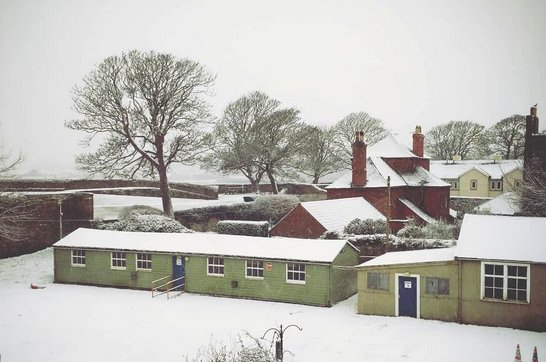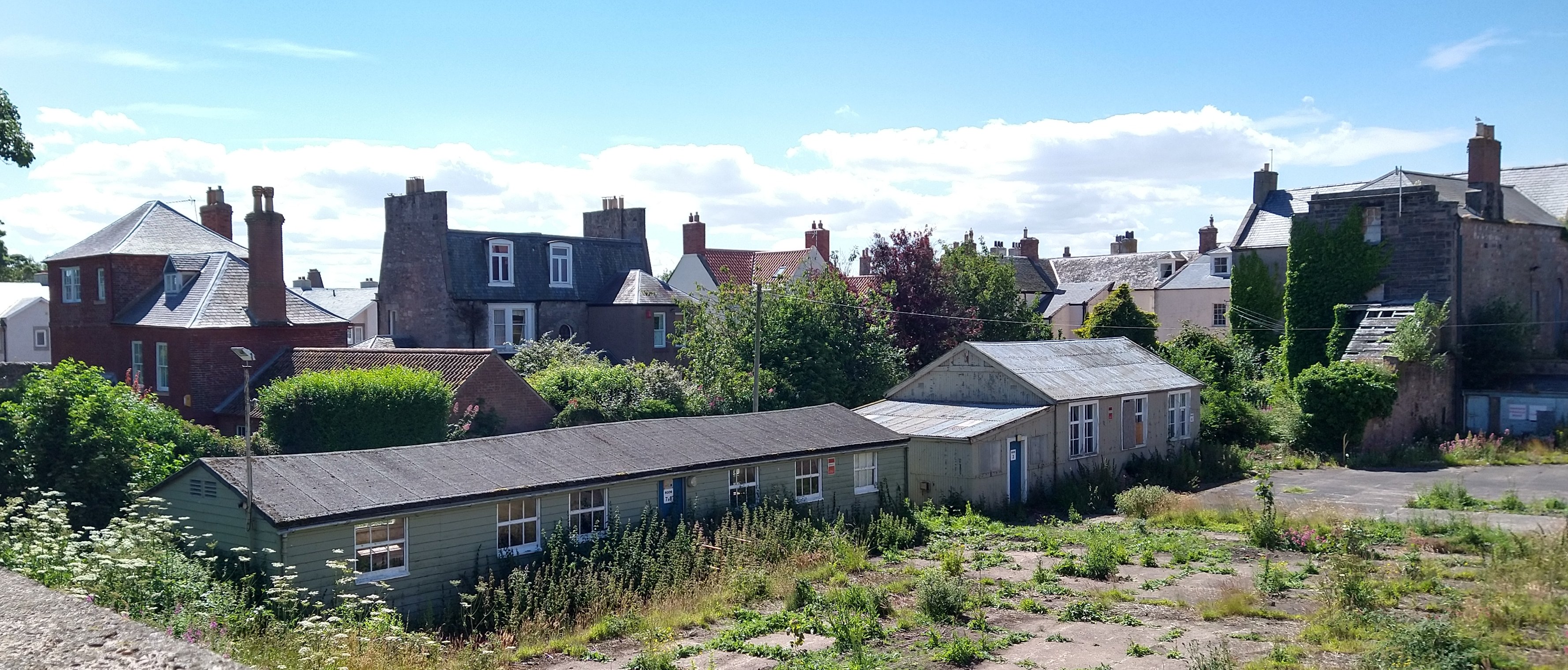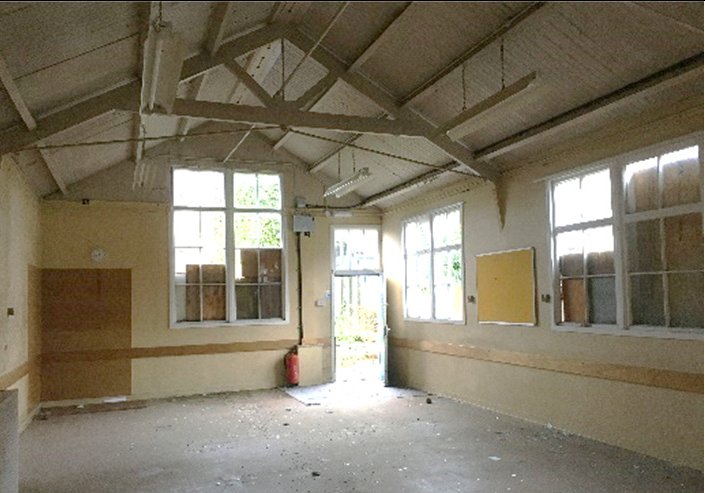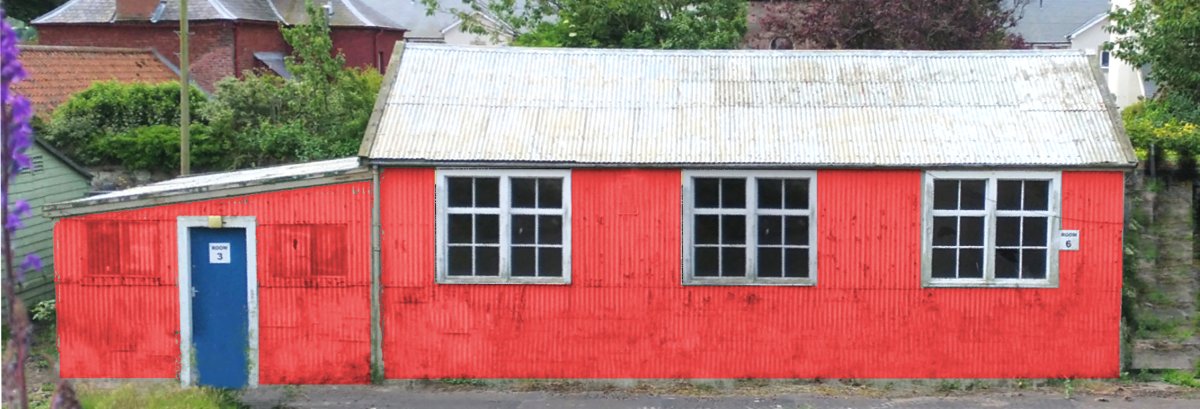These buildings are under threat of demolition under current plans (24/03632/LBC and 24/03631/FUL) although they are supposedly under the protection of the Grammar School Grade II* listing. However, a similar previous application to demolish the huts was approved. Research suggests that they are older and more significant than they appear: they represent heritage assets for Berwick that are worthy of preservation and re-use. You can find the huts at ///stump.danger.soon, near Ness Gate.
This was acquired by Berwick Education Committee in 1920 as temporary classroom accommodation, but probably dates from the early years of the First World War. The hut is about 60 ft long (18.3 m), 15 ft wide (4.5 m) and 10.3 ft high (3.1 m).

The Great War hut in the snow
This is an army hut derived from Armstrong's original design. The width, being at 15 feet smaller than the original Armstrong huts, may be due to the later provision of separate dining rooms removing the need for extra space (thanks to Paul Francis for that detail). It has the original windows and the characteristic louvres for ventilation at either end. The timber exterior is also likely to be original. Some Armstrong Type huts were built with corrugated iron walls, until a nationwide shortage caused by the German monopoly on the production of zinc used to rustproof the iron led to wood being used instead. Photographs of the camp at Alnwick and huts outside the Berwick Barracks show this type.
The Armstrong Hut was constructed to house the large number of recruits following Kitchener’s famous “Your Country Needs You” campaign. Major Bertie Armstrong and a team of Royal Engineers designed seventeen different types of hut to create camps for the expanding army. When they presented their ideas, the army adopted them, although Lord Kitchener considered them “unnecessarily good.” Armstrong is “considered to be the most important architect of the First World War” (The Courier).
These huts were in use in camps at Berwick, Alnwick and Blyth. Some Armstrong huts from Parade in Berwick, by the Barracks - where huts stood in both World Wars - were used for a fever hospital, situated in the ditch between Lord's Mount and the old Edwardian Walls. From the Berwick Advertiser, 31st December, 1920:
“Berwick Sanitary Authority decides to purchase three army huts on the Parade – cookhouse, dining hut and wash-up, for the purpose of a fever hospital at the cost of £600.”
Dispersal of the huts at the various camps occurred at different times, which is probably why the hut at the Grammar School was brought from Blyth, before the Parade huts were put up for sale. From the Berwick Advertiser, 7th May, 1920:
“The Army hut which is to be erected in the playground at Berwick Grammar School to provide temporary accommodation was purchased at the Link House and Gloucester Lodge Camp dispersal sale for £62 18s. It measures 60 feet 9 in. by 15 feet 9 in.”
It was fitted out later that year. An entry in The Berwick Advertiser of 3rd December, 1920 states:
“The Army hut having been erected in Berwick Grammar School, it is being fitted up as a classroom. Messrs Henderson, Bros., Berwick, have received the contracts for the covering of the roof with ruberoid, amounting to £17 17s 6d, and for lining dado and ceiling of the classroom with match boarding, to cost £48 1s.”
And on 8th December, 1920:
“To Messrs Henderson Bros., Berwick, has fallen the contract to remove from Links House Camp, Blyth, the Army hut recently purchased by the Education Authority, and to re-erect it in the playground at Berwick Grammar School for use as a temporary school to accommodate 44 scholars. The equipment of the hut to serve as a class-room, is estimated to cost £230.”
This rare hut therefore has significance for local military history in addition to being part of the history of the Grammar School. Its preservation is advocated by Major Lance Thornton, Executive Officer for The King’s Own Scottish Borderers Association, based at the Barracks. Local historian and photographer Cameron Robertson points out that as huts were dispersed or demolished at the end of the First World War, and new huts built for the Second World War, the hut at Palace Street is an 'unlikely survivor'.
This interesting building was commissioned by the Governors of the Grammar School in 1908 from Speirs & Co., a well-known firm of manufacturers and builders in Glasgow. The structure is prefabricated and made from corrugated iron. The building was used for technical classes and as a bike store. The hut is approximately 52.5 ft (16 m) long - 18 ft (5.4 m) of which is the cycle store - 19 ft (5.8 m) wide and 17.5 ft (5.3 m) high.
The original drawings survive in the Berwick archive and many of the details survive in the building.

The Army and Speirs huts

The spacious Speirs hut classroom interior

How the Speirs hut might look if painted red
There is also a small motor house dating from 1924, tucked behind this hut. Nothing more is known at this point about this structure.
No doubt there is much more history to be written, from first-hand accounts of students and teachers who used the Grammar School huts, and perhaps descendants of soldiers who were housed in Armstrong huts.
Thanks to John Convey for finding the hut drawings and Berwick Advertiser cutting in the Berwick town archive.
Armstrong Huts in the Great War (1914-1918), Karey L. Draper and James W. P. Campbell Queens’ College, University of Cambridge.
Corrugated Iron Buildings. Nick Thomson, Shire Library, 2011.
Wartime Huts: The Development, Typology and Identification of Temporary Military Buildings in Britain 1914-1945. Karey L. Draper, Faculty of Architecture University of Cambridge.
The Hutting Problem in the War. Major General Sir George Scott-Moncrieffe, K.C.B., K.C.M.G., C.I.E. The Royal Engineers Journal, September 1924.
This Week in World War One, 7 January 1916, Northumberland Archives, mentioning the presence of huts in Parade.
Berwick Record Office: BPR 1, Page 7, 1908, Palace Street Berwick, School, Grammar School, Speirs & Company, Box 1. BPR 1, 18, 10/7/20, 29, Grammar School, Berwick, Temporary Building, Education Committee, Walker, T, Architect to Education Committee, Box 5. BPR1, 25, 5/1/24, 30, Grammar School, Berwick, Motor House, Ballard, G. H., Unknown, Box 8.